When exploring blockchain security, you, as a reader with a keen interest in blockchain technology, will encounter advanced protocols designed to safeguard digital transactions and assets effectively. Each protocol plays a vital role, from the energy-intensive Proof of Work (PoW) to the energy-efficient Proof of Stake (PoS) used in networks like Cardano and Polkadot.
Delegated Proof of Stake (DPoS) enhances transaction speed and efficiency, while Byzantine Fault Tolerance (BFT) guarantees network resilience. Innovative approaches such as Ring Signatures and Zero-Knowledge Proofs add layers of anonymity and security. Multi-signature protocols mitigate risks of theft, and Hierarchical Deterministic Wallets revolutionize key management for enhanced security and convenience. Your understanding of these protocols is essential for ensuring the safety and reliability of blockchain technology in the digital age.
Brief Overview of Evaluating Blockchain Security Protocols
- Directed Acyclic Graph (DAG) enhances scalability and speed through non-linear transaction organization.
- Ring Signatures ensure signer anonymity, which is commonly used in privacy-focused cryptocurrencies.
- Zero-knowledge proofs provide privacy and security by allowing verification without data exposure.
- Multi-signature protocols enhance transaction security by requiring multiple keys for authorization.
- Hierarchical Deterministic Wallets revolutionize key management by generating a master seed for all keys, improving security and convenience.
Proof of Work (PoW)
If you want to understand how blockchain networks like Bitcoin validate transactions, Proof of Work (PoW) is an important concept to grasp. In PoW, miners play a vital role in maintaining the network’s security by solving complex mathematical puzzles to add new blocks to the blockchain. This consensus mechanism guarantees that transactions are legitimate and secure.
Miners compete against each other to be the first to find the correct solution, requiring significant computational power and energy consumption. This competitive nature of PoW makes it economically infeasible for malicious actors to manipulate the blockchain, thereby safeguarding the integrity of the system.
While PoW effectively enhances security, it has drawn criticism for its high energy consumption levels. Solving these intricate puzzles demands substantial computational resources, leading to environmental concerns. Despite these drawbacks, PoW’s robustness in preventing fraudulent activities showcases its importance in maintaining the trust and reliability of blockchain networks.
Proof of Stake (PoS)
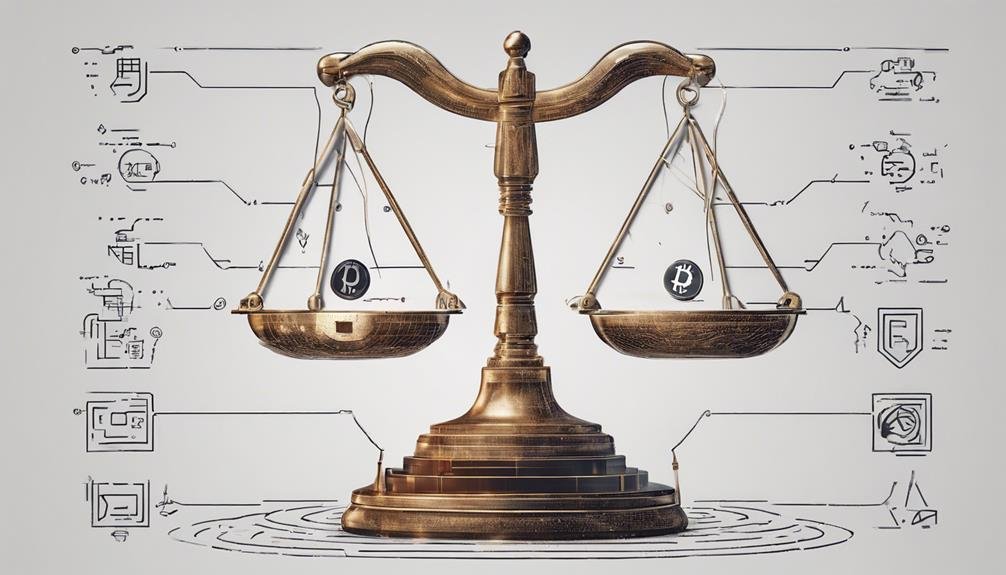
To further understand the validation process in blockchain networks like Bitcoin, delving into Proof of Stake (PoS) reveals a different approach to securing transactions and creating new blocks. In PoS, validators play an essential role in maintaining the blockchain’s integrity by staking tokens as collateral to be chosen to validate transactions and generate new blocks.
This consensus mechanism, used in networks such as Cardano and Polkadot, is praised for its energy-efficient nature compared to the power-intensive Proof of Work (PoW) utilized by Bitcoin.
Delegated Proof of Stake (DPoS)
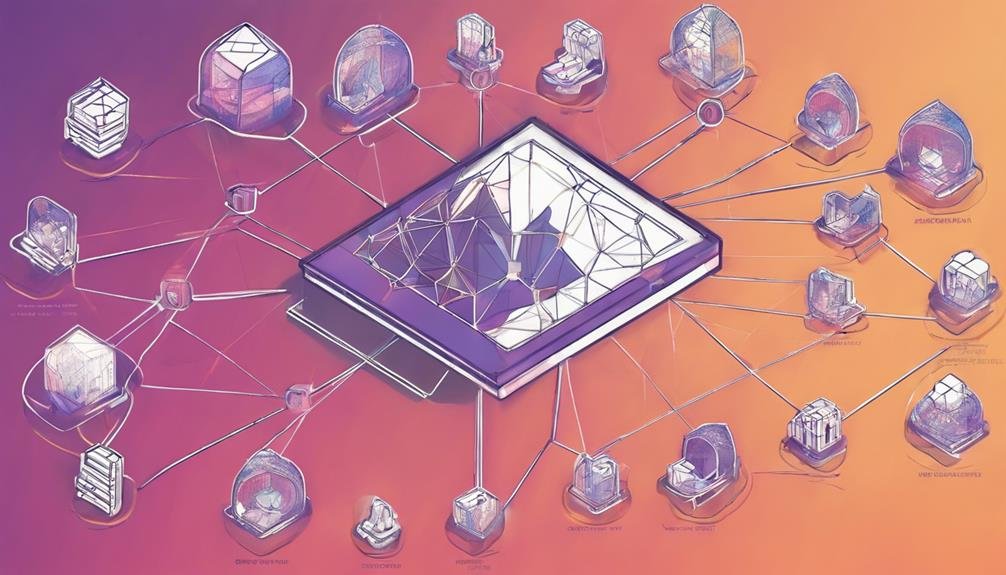
In Delegated Proof of Stake (DPoS), token holders participate in selecting delegates to validate transactions on the blockchain. DPoS is a consensus mechanism that aims to enhance transaction speed and efficiency by relying on a chosen group of trusted delegates for block validation. By allowing token holders to vote for delegates, DPoS guarantees that the network remains secure while promoting transparency and accountability in block validation.
The voting power of token holders plays a vital role in determining the influence and responsibilities of delegates within the network. This democratic approach enhances scalability by decreasing the number of validators and leads to faster block confirmation times. DPoS stands out for its ability to provide a secure and efficient blockchain environment where token holders actively contribute to maintaining the network’s integrity by participating in selecting delegates for block validation.
Practical Byzantine Fault Tolerance (PBFT)

When discussing Practical Byzantine Fault Tolerance (PBFT), it is vital to grasp its consensus mechanism and its advantages regarding fault tolerance. PBFT necessitates a substantial majority of honest nodes to achieve agreement, guaranteeing network integrity even in the presence of faulty or malicious participants. PBFT plays a critical role in securing distributed systems like blockchain networks by upholding safety and liveness properties.
PBFT Consensus Mechanism
Ensuring security and agreement in distributed systems, the PBFT (Practical Byzantine Fault Tolerance) consensus mechanism requires a two-thirds majority of nodes to agree on the transaction order, making it resilient against Byzantine failures. PBFT is commonly utilized in permissioned blockchain networks, where all participants are known and trusted, ensuring rapid transaction finality.
This mechanism operates through a series of communication rounds where nodes exchange messages to achieve consensus on transaction validity. PBFT’s strength lies in its consistency and fault tolerance, even in the presence of malicious nodes or network failures. By requiring a significant majority to agree on transactions, PBFT enhances the security and reliability of distributed systems, making it a valuable tool for ensuring the integrity of blockchain networks.
Fault Tolerance Benefits
Implementing Practical Byzantine Fault Tolerance (PBFT) in blockchain networks guarantees robust fault tolerance capabilities. PBFT, a consensus algorithm, enhances security by necessitating a two-thirds majority of nodes to validate transactions, thwarting malicious activities. This protocol can withstand up to one-third of nodes behaving erroneously while preserving network agreement.
Typically deployed in permissioned blockchain networks where node identities are trusted, PBFT fortifies the reliability and integrity of systems by addressing the risks associated with Byzantine failures. By employing PBFT, blockchain networks ensure that consensus is reached securely, even with potential faults or malicious actors, offering a safety net against disruptions that could compromise the network’s operations.
Byzantine Fault Tolerance (BFT)

Byzantine Fault Tolerance (BFT) is a pivotal consensus mechanism within blockchain security frameworks designed to address the Byzantine Generals’ Problem. Here are some critical points about BFT that highlight its importance in guaranteeing the safety of blockchain networks:
- BFT guarantees the network’s resilience against malicious actors or nodes providing incorrect information.
- The BFT protocol requires a two-thirds majority of honest nodes to reach a consensus on the validity of transactions.
- BFT protocols like PBFT (Practical Byzantine Fault Tolerance) are used in permissioned blockchain networks for fast and secure transaction processing.
- These protocols enhance the reliability and fault tolerance of blockchain systems, which is essential for maintaining distributed ledgers’ integrity.
Directed Acyclic Graph (DAG)
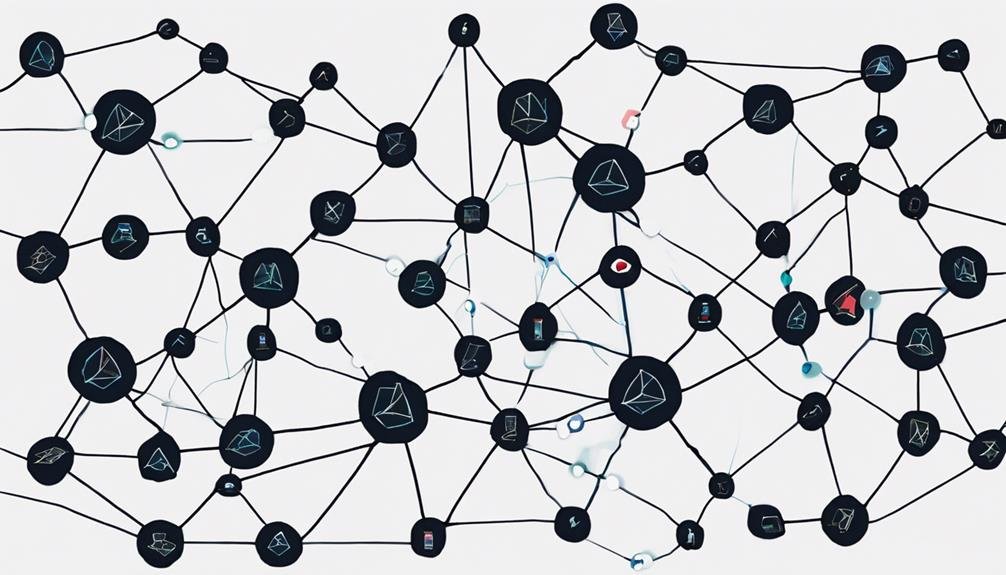
When exploring Directed Acyclic Graph (DAG), you’ll find that its unique structure offers a non-linear approach to organizing transactions, enhancing scalability and speed significantly. This protocol’s security features, including trustless consensus mechanisms and parallel transaction processing, contribute to its efficiency and robustness. Understanding the DAG structure overview and its security characteristics is vital for grasping its impact on blockchain technology.
DAG Structure Overview
Understanding the DAG structure in blockchain technology is essential for grasping how specific protocols achieve scalability and speed in transaction processing.
- DAG is a non-linear data structure used in blockchain protocols like IOTA and Nano for fast transaction processing.
- It eliminates blocks and miners, allowing asynchronous validation of transactions.
- Each new transaction in a DAG-based system must approve two previous transactions, creating a web-like structure.
- DAG enables parallel processing of transactions, enhancing efficiency in blockchain networks.
- The structure of DAG enhances scalability, making it a valuable asset in blockchain technology.
DAG Security Features
Understanding the security features of Directed Acyclic Graph (DAG) is essential for evaluating the strength of blockchain protocols like IOTA and Nano. DAG, utilized in these protocols, enables fast transactions and high throughput. By eliminating mining, DAG allows seamless transactions, enhancing user experience and efficiency. The unique structure of DAG permits multiple transactions to occur concurrently, improving scalability considerably.
In a DAG network, each new transaction confirms two previous transactions, creating a robust security mechanism. This approach enhances the trustworthiness of the blockchain protocols, making them suitable for applications requiring secure and swift transactions. DAG-based systems offer the potential for increased transaction speed and network capacity, addressing the growing demands for efficiency in the digital landscape.
Ring Signature

Delving into the domain of blockchain security, let’s explore how Ring Signatures revolutionize anonymity in digital signatures.
- Ring Signature is a decentralized cryptographic protocol allowing users to anonymously sign a message.
- Introduced in 2001 by Ron Rivest, Adi Shamir, and Yael Tauman, Ring Signatures guarantee the signer’s identity within the group remains anonymous.
- This protocol is utilized in privacy-focused cryptocurrencies like Monero to obscure transaction details, enhancing user privacy.
- By combining multiple users’ signatures, Ring Signatures make it impossible to trace the signature back to any specific individual, ensuring anonymity.
- Through this innovative approach, Ring Signatures provide a secure way to conduct transactions while prioritizing privacy and confidentiality, making them essential in safeguarding sensitive information within the blockchain ecosystem.
Zero-Knowledge Proof
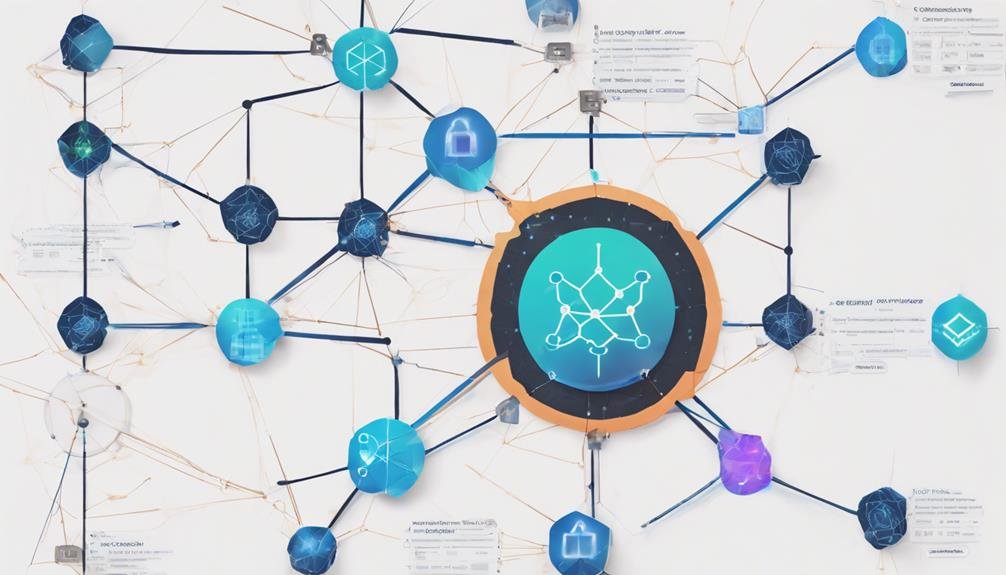
Utilizing advanced cryptographic techniques, Zero-Knowledge Proofs enables parties to validate information securely without divulging sensitive data. In blockchain technology, Zero-Knowledge Proofs are essential in guaranteeing privacy and security. This protocol enhances the confidentiality of data exchanges by allowing verification of transactions and smart contracts without revealing specific details such as account balances or identities.
Zero-knowledge proofs provide a way to verify the accuracy of statements without exposing the underlying information, reducing the risk of data breaches in blockchain systems. This method ensures trust in transactions and maintains the privacy of involved parties. With Zero-Knowledge Proofs, the focus shifts from revealing sensitive data to proving the validity of information, strengthening the overall security posture of blockchain networks. Embracing this cryptographic protocol adds a layer of protection vital in today’s digital landscape, where safeguarding sensitive information is paramount.
Multi-Signature

Multi-signature security protocols in blockchain technology offer enhanced transaction security. This system offers a robust multiple-key verification process by requiring multiple private keys for authorization. Additionally, the distributed control mechanism in multi-signature setups adds layers of security, reducing the risk of unauthorized access.
Enhanced Transaction Security
Enhancing transaction security through multi-signature protocols involves requiring multiple private keys to authorize a transaction, thereby reducing the risk of a single point of failure. Regarding blockchain security, multi-signature technology offers enhanced verification and protection against unauthorized transactions. Here are some key points to take into account:
- Each transaction requires signatures from specified parties, adding an extra layer of security.
- Multi-signature addresses allow customization based on security needs, such as 2-of-3 or 3-of-5 signatures.
- In case of a compromised key, remaining authorized parties can prevent fraudulent transactions.
- Multi-signature technology is widely used in cryptocurrency wallets, exchanges, and smart contracts.
- Implementing multi-signature protocols can help mitigate the risk of theft and unauthorized access.
Multiple Key Verification
To bolster security in blockchain transactions, consider implementing the multi-signature protocol, also known as multi-sig, which requires multiple private keys for authorization. This protocol provides protection in cryptocurrency wallets, exchanges, and smart contracts. With multi-sig, a subset of 2 or more keys is needed to complete a transaction, reducing the risk of unauthorized access. By requiring multiple approvals for financial transactions, multi-signature enhances security by preventing a single point of failure.
It is a shared security model that utilizes digital signatures and is particularly useful in decentralized applications. Incorporating multi-sig can help safeguard against theft, fraud, and unauthorized activities. It is a valuable tool in blockchain security, especially in Proof of Stake (PoS) systems.
Distributed Control Mechanism
Implementing a distributed control mechanism through multi-signature protocols in blockchain security provides enhanced protection against unauthorized actions. By requiring multiple private keys for transaction authorization, multi-signature protocols add a layer of security to digital assets. Here are five key points about multi-signature protocols in blockchain security:
- Multiple private keys are needed to authorize transactions, boosting security.
- Distributed control mechanisms prevent single entities from having complete control.
- Predetermined signatures are necessary to validate transactions, enhancing protection.
- Widely used in cryptocurrency wallets and exchanges to avoid single points of failure.
- Multi-signature technology safeguards digital assets and transactions in the blockchain industry effectively.
Hierarchical Deterministic Wallets
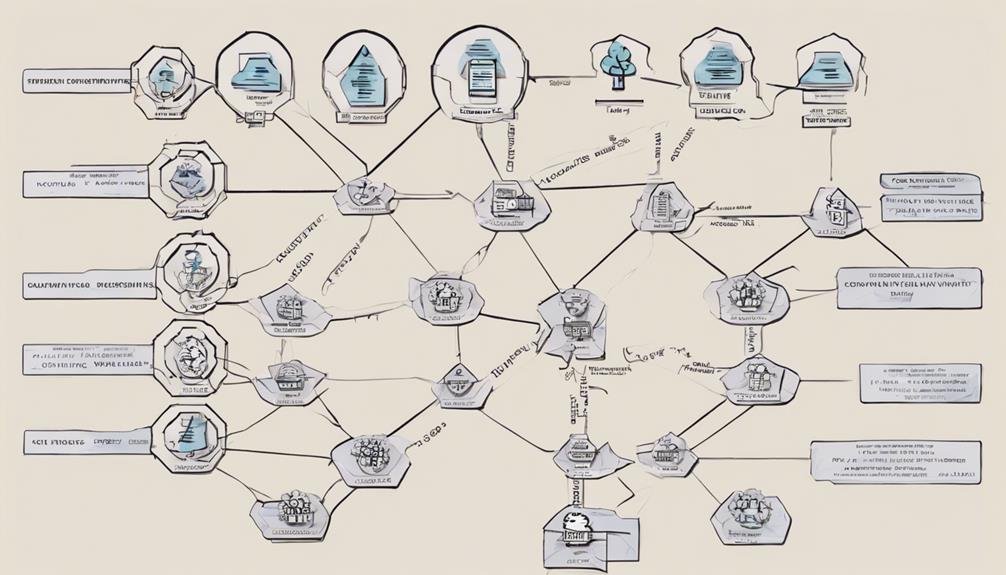
Hierarchical Deterministic Wallets, or HD Wallets, revolutionize key management in blockchain transactions by generating a master seed to derive all keys. This deterministic algorithm enables secure key management by systematically deriving keys, making it easier to back up and restore your wallet without losing funds. With each key in the HD Wallet derived from the master seed, users can generate unlimited addresses from a single seed, enhancing both security and convenience.
The hierarchical structure of HD Wallets organizes keys efficiently, allowing for easy wallet recovery and ensuring that your keys are securely managed. This hierarchical nature not only enhances privacy and usability but also strengthens the security of blockchain transactions. Embracing HD Wallets can provide a safer and more organized approach to managing cryptocurrency assets.
Frequently Asked Questions
What Is the Most Common Blockchain Protocol?
The most common blockchain protocol is Bitcoin, a decentralized system using a proof-of-work consensus mechanism. It guarantees immutability and transparency in transactions. Bitcoin’s market capitalization is in the billions, making it a dominant cryptocurrency force. Public vs private blockchains, consensus mechanisms, scalability solutions, permissioned networks, smart contract auditing, and cryptographic hashing are key elements enhancing security in blockchain technology. Be mindful of these aspects for a safer experience.
What Are the Three Main Blockchain Protocols?
The three main blockchain protocols are Bitcoin, Ethereum, and Hyperledger. Bitcoin relies on a consensus mechanism called Proof of Work for security. Ethereum offers smart contracts, enabling automated transactions. Hyperledger emphasizes privacy features that are suitable for enterprise use. Each protocol addresses network scalability and interoperability, catering to diverse needs in the blockchain ecosystem. Understanding these protocols’ strengths can help you navigate the complexities of blockchain technology and make informed decisions regarding tokenomics.
What Is the Most Secure Type of Blockchain?
When considering the security of blockchain networks, the most secure type often utilizes advanced cryptographic algorithms for data protection. Platforms with solid consensus mechanisms like Proof of Stake (PoS) or Proof of Work (PoW) are highly regarded for their security features. Private blockchains that restrict access offer enhanced security. Implementing multi-factor authentication, encryption, and regular security audits can strengthen security. Network architecture, governance models, and regulatory compliance influence blockchain security.
Which Protocol Is Used by Blockchain Networks for Security Purposes?
Blockchain networks employ decentralized consensus mechanisms like Proof of Work (PoW), Proof of Stake (PoS), and Delegated Proof of Stake (DPoS) for security. These protocols guarantee the immutability of the ledger through cryptographic hashing, public key encryption, and distributed networks. Smart contract execution further boosts security. Overall, these protocols collectively protect blockchain networks from malicious activities, ensuring the safety and integrity of transactions.
Conclusion
Ultimately, blockchain security protocols play a vital role in safeguarding digital transactions. Utilizing a combination of PoW, PoS, DPoS, PBFT, BFT, Ring Signature, Zero-Knowledge Proof, Multi-Signature, and Hierarchical Deterministic Wallets maintains the integrity and trustworthiness of blockchain networks. Each protocol offers unique features and benefits, enhancing the system’s overall security. Understanding these protocols is essential for ensuring the safety and reliability of blockchain technology in the digital age.










